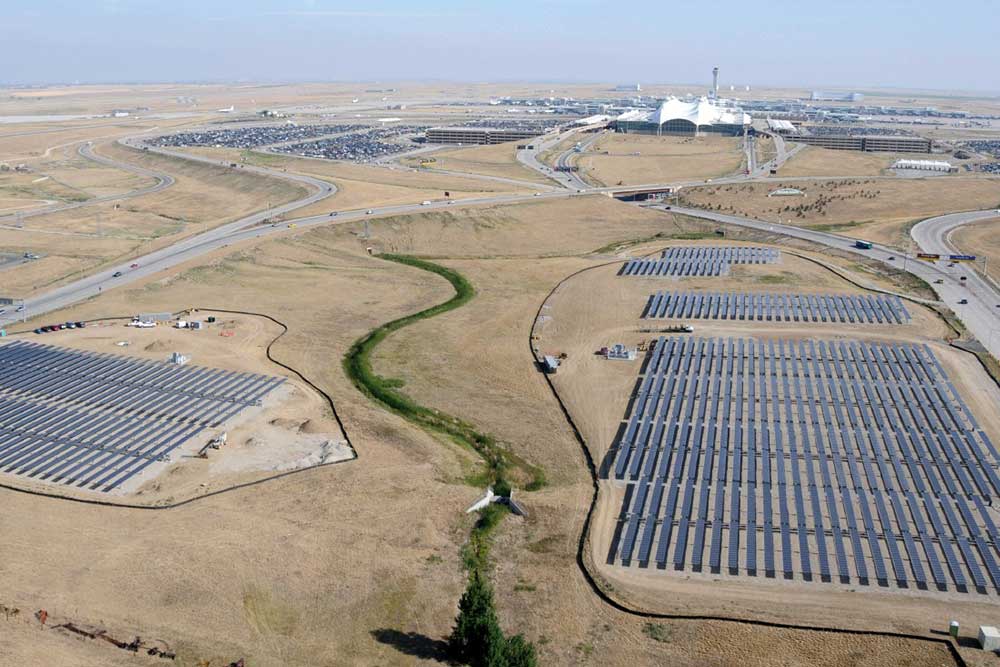Research and Analysis Demonstrate the Lack of Impacts of Glare from Photovoltaic Modules
July 31, 2018 by Megan Day and Benjamin Mow
Local objections to proposed solar photovoltaic (PV) installations sometimes include concerns that the modules will cause glare that could impact neighbors or aviation. Research on this subject demonstrates that PV modules exhibit less glare than windows and water.
Solar PV modules are specifically designed to reduce reflection, as any reflected light cannot be converted into electricity. PV modules have been installed without incident at many airports. This post summarizes research on PV system glare issues and compiles resources and key take-aways on the subject.

Resources and Research:
- Summary: This study examined the flash glare a pilot could experience from a 25-degree fixed-tilt flat-plate polycrystalline PV system located near Las Vegas, Nevada. The study modeled the amount of visible radiation that would be reflected from a PV module for every hour between 1998 and 2004 and calculated the hourly retinal irradiance. The retinal irradiance was compared to known ocular safety metrics.
- Key Takeaways: “The results show that the potential for hazardous glare from flat-plate PV systems is similar to that of smooth water and not expected to be a hazard to air navigation” (p. 4)
U.S. Department of Energy Solar PV and Glare Fact Sheet
- Key Takeaways: Modern PV panels reflect as little as two percent of incoming sunlight, about the same as water and less than soil or even wood shingles. Much of the misperception surround solar and glare is likely due to confusion between solar PV and concentrated solar power (CSP), which use a system of large mirrors to direct sunlight.
General Design Procedures for Airport-Based Solar Photovoltaic Systems
- Summary: “[R]eflection from a PV front glass surface without any antireflecting (AR) coating is less intense than that of water” (p.10). PV modules are increasingly coated with anti-reflection materials, so it is expected that modules will be less reflective in the future. The most straightforward method to eliminate all glare problems is to use Sandia Laboratory’s Solar Glare Hazard Analysis Tool (SGHAT), which determines when and where solar glare can occur throughout the year from a user-specified PV array view from user-prescribed observation points.
- Key Takeaways: “The reflection off a solar PV panel from most near normal angles is less than 3% and represents no risk to air traffic” (p. 10).
Massachusetts Department of Energy Resources Clean Energy Results: Questions & Answers Ground-Mounted Solar Photovoltaic Systems
- Key Takeaways: Most solar panels are designed with anti-reflective glass front surfaces and only reflect about 2 percent of incoming light. United Kingdom and U.S. aircraft databases contain no cases of accidents in which glare caused by a solar energy facility was cited as a factor.
Resources specific to siting PV at airports include:
- Technical Guidance for Evaluating Selected Solar Technologies on Airports
- Implementing Solar Technologies at Airports
- Federal Aviation Administration; Interim Policy, FAA Review of Solar Energy Systems Projects on Federally Obligated Airports
As detailed in these reports, with proper planning and modeling, solar PV is compatible with aviation and has reflectivity similar to water.
Additional misperceptions about large-scale PV are discussed in a 2016 STAT Blog: Top Five Large-Scale Solar Myths. Local and state governments can access technical assistance regarding potential impacts and benefits of PV through the Department of Energy’s Solar Technical Assistance Team and SolSmart programs.
Share

